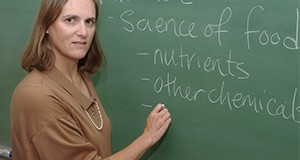
Good teaching begins with well-written instructional objectives. Instructional objectives identify the knowledge, skills, and abilities that students will possess upon successfully learning the material. This four-page fact sheet outlines the three types of objectives (cognitive, psychomotor, and affective) as well as the different components of objectives (condition, performance, criterion). A well-written instructional objective will lead to clear teaching and ultimately, student success. Written by R. Kirby Barrick and Andrew C. Thoron, and published by the Agricultural Education and Communication Department.
http://edis.ifas.ufl.edu/wc245
Category: Community Development
What Else Can Surface Water Buffer Systems Do?: Exploring Multiple Ecosystem Services
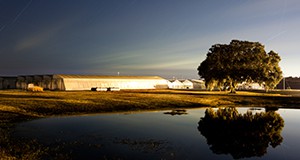 As society confronts the consequences of global warming, deteriorating water quality, and impoverished biodiversity, there is a growing urgency to develop and expand water buffers' multifunctional ecosystem services. However, limited information is available on other potential co-benefits associated with the use of buffers, particularly VFSs. This 5-page fact sheet provides information on buffers' multiple ecosystem benefits, such as niche products production, carbon sequestration, and flood risk mitigation, as well as recommendations on future research needs necessary to enhance multiple ecosystem services and benefits of buffers. Written by Lei Wu, Rafael Muñoz-Carpena, and Yuncong Li, and published by the UF Department of Soil and Water Science, November 2015.
As society confronts the consequences of global warming, deteriorating water quality, and impoverished biodiversity, there is a growing urgency to develop and expand water buffers' multifunctional ecosystem services. However, limited information is available on other potential co-benefits associated with the use of buffers, particularly VFSs. This 5-page fact sheet provides information on buffers' multiple ecosystem benefits, such as niche products production, carbon sequestration, and flood risk mitigation, as well as recommendations on future research needs necessary to enhance multiple ecosystem services and benefits of buffers. Written by Lei Wu, Rafael Muñoz-Carpena, and Yuncong Li, and published by the UF Department of Soil and Water Science, November 2015.
http://edis.ifas.ufl.edu/ss647
Economic Contributions and Ecosystem Services of Springs in the Lower Suwannee and Santa Fe River Basins of North-Central Florida
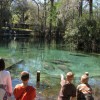 This study examined the economic contributions, consumer surplus, and ecosystem services provided by recreational use of fifteen major springs sites in north central Florida. The estimated annual economic contributions of springs-related recreational spending in north-central Florida for FY 2012/13 are summarized. Among the findings, there was $84.2 million in total visitor spending for springs recreation, and 1,160 full- and part-time jobs. This 4-page fact sheet was written by Tatiana Borisova, Alan W. Hodges, and Thomas J. Stevens, and published by the UF Department of Food and Resource Economics, April 2015.
This study examined the economic contributions, consumer surplus, and ecosystem services provided by recreational use of fifteen major springs sites in north central Florida. The estimated annual economic contributions of springs-related recreational spending in north-central Florida for FY 2012/13 are summarized. Among the findings, there was $84.2 million in total visitor spending for springs recreation, and 1,160 full- and part-time jobs. This 4-page fact sheet was written by Tatiana Borisova, Alan W. Hodges, and Thomas J. Stevens, and published by the UF Department of Food and Resource Economics, April 2015.
http://edis.ifas.ufl.edu/fe958
Conservation Subdivision: Post-construction Phase: Policy Directions and the Importance of Assessing Stakeholder Opinions
 Simply designating open space in a development is not enough to provide long-term protection for a variety of wildlife. New policies need to be developed that encourage developers of conservation developments to adopt long-term management practices that support biodiversity conservation. This 5-page fact sheet discusses policy options that could be used to support conservation management practices and reports on a survey of Colorado landowners who have created conservation developments and their opinions about a policy option to support the implementation of management practices. Written by Daniel Feinberg and Mark Hostetler, and published by the UF Department of Wildlife Ecology and Conservation, December 2014. (Photo credit: Daniel Feinberg)
Simply designating open space in a development is not enough to provide long-term protection for a variety of wildlife. New policies need to be developed that encourage developers of conservation developments to adopt long-term management practices that support biodiversity conservation. This 5-page fact sheet discusses policy options that could be used to support conservation management practices and reports on a survey of Colorado landowners who have created conservation developments and their opinions about a policy option to support the implementation of management practices. Written by Daniel Feinberg and Mark Hostetler, and published by the UF Department of Wildlife Ecology and Conservation, December 2014. (Photo credit: Daniel Feinberg)
http://edis.ifas.ufl.edu/uw401
Is My Tree Safe? Recognizing Conditions that Increase the Likelihood of Tree Failure
 Urban trees provide shade and beauty and the urban forest as a whole provides a wealth of benefits to neighborhoods and residents. But stresses from the urban environment may lead to problems that pose an unacceptable safety risk to people and property. It is a landowner’s responsibility to ensure that the trees on their property are safe. A key step in reducing the potential for tree-related injury or property damage is learning to identify common tree defects associated with increased risk of failure. This 5-page fact sheet highlights seven easily reconizable tree defects that homeowners and non-professionals in public agencies. may encounter in Florida. Written by Drew C. McLean, Andrew K. Koeser, Robert J. Northrop, and Gitta Hasing, and published by the UF Department of Environmental Horticulture, October 2014. (Photo by Gitta Hasing)
Urban trees provide shade and beauty and the urban forest as a whole provides a wealth of benefits to neighborhoods and residents. But stresses from the urban environment may lead to problems that pose an unacceptable safety risk to people and property. It is a landowner’s responsibility to ensure that the trees on their property are safe. A key step in reducing the potential for tree-related injury or property damage is learning to identify common tree defects associated with increased risk of failure. This 5-page fact sheet highlights seven easily reconizable tree defects that homeowners and non-professionals in public agencies. may encounter in Florida. Written by Drew C. McLean, Andrew K. Koeser, Robert J. Northrop, and Gitta Hasing, and published by the UF Department of Environmental Horticulture, October 2014. (Photo by Gitta Hasing)
http://edis.ifas.ufl.edu/ep507
Maps of Charlotte County General Permit Trafficshed Channels and Secondary Channels
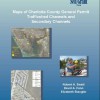 This 33-page collection of maps depicts channels included in the Charlotte County General Permit (GP)1. Each map shows either channel segments within a GP trafficshed or segments in a GP secondary channel system. Written by Robert A. Swett, David A. Fann, and Elizabeth Staugler, and published on EDIS by Florida Sea Grant, October 2014.
This 33-page collection of maps depicts channels included in the Charlotte County General Permit (GP)1. Each map shows either channel segments within a GP trafficshed or segments in a GP secondary channel system. Written by Robert A. Swett, David A. Fann, and Elizabeth Staugler, and published on EDIS by Florida Sea Grant, October 2014.
http://edis.ifas.ufl.edu/sg133
Extension and Community Resilience: Improving Community Disaster Preparedness Using Online Resources
 As Extension agents work to improve the quality of life in their communities, they must increase the capacity to respond to disasters, especially in high risk areas (which includes most of coastal Florida). Community Resiliency is a community’s ability to quickly recover from adversity and it can be enhanced through planning and adaptation using easily available online resources. This 4-page fact sheet describes supplemental educational materials that can be added to community resiliency training, offering background information and specific tools for disaster preparation. Written by Emily Ott, Paul Monaghan, and Timothy Fogarty, and published by the UF Department of Agricultural Education and Communication, October 2014. (UF/IFAS photo by Milt Putnam)
As Extension agents work to improve the quality of life in their communities, they must increase the capacity to respond to disasters, especially in high risk areas (which includes most of coastal Florida). Community Resiliency is a community’s ability to quickly recover from adversity and it can be enhanced through planning and adaptation using easily available online resources. This 4-page fact sheet describes supplemental educational materials that can be added to community resiliency training, offering background information and specific tools for disaster preparation. Written by Emily Ott, Paul Monaghan, and Timothy Fogarty, and published by the UF Department of Agricultural Education and Communication, October 2014. (UF/IFAS photo by Milt Putnam)
http://edis.ifas.ufl.edu/wc187
Measuring Community Resilience using Online Toolkits
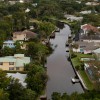 When we return to the scene of recent disasters like New Orleans, we find that some communities and neighborhoods are able to recover faster than others, while some never completely recover. Community Resilience is defined as the ability for a community to bounce back from a disaster, adapt to changes, and become more sustainable. The resilience assessment and planning tools reviewed here range from simple, ready-to-print worksheets intended for use by average citizens to comprehensive planning exercises more appropriate for city planners, emergency service providers, and elected officials. Not all of the toolkits will apply to every community. This 6-page fact sheet was written by Paul Monaghan, Emily Ott, and Timothy Fogarty, and published by the UF Department of Agricultural Education and Communication, July 2014. (UF/IFAS photo by Tyler Jones)
When we return to the scene of recent disasters like New Orleans, we find that some communities and neighborhoods are able to recover faster than others, while some never completely recover. Community Resilience is defined as the ability for a community to bounce back from a disaster, adapt to changes, and become more sustainable. The resilience assessment and planning tools reviewed here range from simple, ready-to-print worksheets intended for use by average citizens to comprehensive planning exercises more appropriate for city planners, emergency service providers, and elected officials. Not all of the toolkits will apply to every community. This 6-page fact sheet was written by Paul Monaghan, Emily Ott, and Timothy Fogarty, and published by the UF Department of Agricultural Education and Communication, July 2014. (UF/IFAS photo by Tyler Jones)
http://edis.ifas.ufl.edu/wc172
How to Start a Food Business: Introduction
 While running your own food business can be a rewarding and exciting experience, it can be overwhelming and stressful. It is important to understand the pros and cons of running your own food business and decide if you are ready to pursue a food business venture. This 3-page fact sheet was written by Soohyoun Ahn, Renee Goodrich-Schneider, and Amarat H. Simonne, and published by the UF Department of Food Science and Human Nutrition, September 2014.
While running your own food business can be a rewarding and exciting experience, it can be overwhelming and stressful. It is important to understand the pros and cons of running your own food business and decide if you are ready to pursue a food business venture. This 3-page fact sheet was written by Soohyoun Ahn, Renee Goodrich-Schneider, and Amarat H. Simonne, and published by the UF Department of Food Science and Human Nutrition, September 2014.
http://edis.ifas.ufl.edu/fs254
Mapping Your World with Community Analyst: An Easy to Use Tool to Map the Characteristics of U.S. Communities
 In recent years, the number of mapping and geospatial tools that are both feature-rich and easy to use has increased. This is good news because it allows many more of us to capitalize on the power and unique insights that such tools can provide without having to spend inordinate amounts of time learning how to use them. This article presents Community Analyst, a web application that provides access to thousands of business, demographic, economic, education, and health data variables for the United States. The application’s extensive suite of data metrics, in conjunction with on-demand reports and interactive color-coded maps, allows one to quickly explore the characteristics of one or more geographic areas. This 9-page fact sheet was written by Robert Swett and Lisa Krimsky, and published by the UF Department of School of Forest Resources and Conservation, October 2014.
In recent years, the number of mapping and geospatial tools that are both feature-rich and easy to use has increased. This is good news because it allows many more of us to capitalize on the power and unique insights that such tools can provide without having to spend inordinate amounts of time learning how to use them. This article presents Community Analyst, a web application that provides access to thousands of business, demographic, economic, education, and health data variables for the United States. The application’s extensive suite of data metrics, in conjunction with on-demand reports and interactive color-coded maps, allows one to quickly explore the characteristics of one or more geographic areas. This 9-page fact sheet was written by Robert Swett and Lisa Krimsky, and published by the UF Department of School of Forest Resources and Conservation, October 2014.
http://edis.ifas.ufl.edu/fr383
Speaking with Policymakers About Current Issues
 The future of the agricultural and natural resource industry requires that educators, industry professionals, and policymakers work together when addressing contentious issues. However, discussing contentious issues with policymakers at the local, state, and national level is not always an easy task. Policymakers in general are busy people with many issues competing for their limited time. Once in the door, it is important to deliver strong messages in the right way for the policymaker to listen and use your information when making important decisions. This 2-page fact sheet discusses the differences between education and persuasion and when to use each, offers information on how to make presentations that will get their attention, and identifies things to avoid when visiting with a policymaker. Written by Alexa J. Lamm, and published by the UF Department of Agricultural Education and Communication, August 2013.
The future of the agricultural and natural resource industry requires that educators, industry professionals, and policymakers work together when addressing contentious issues. However, discussing contentious issues with policymakers at the local, state, and national level is not always an easy task. Policymakers in general are busy people with many issues competing for their limited time. Once in the door, it is important to deliver strong messages in the right way for the policymaker to listen and use your information when making important decisions. This 2-page fact sheet discusses the differences between education and persuasion and when to use each, offers information on how to make presentations that will get their attention, and identifies things to avoid when visiting with a policymaker. Written by Alexa J. Lamm, and published by the UF Department of Agricultural Education and Communication, August 2013.
http://edis.ifas.ufl.edu/wc152
Improving Savings, Health, and Happiness by Re-examining Your Practices and Surroundings series
 This series of EDIS publications introduces readers to the concept of overall community performance and suggests minor modifications to neighborhoods, public schools, and public services that could help citizens improve their communities. This publication is for a general audience and provides a list of changes to public schools that, if enacted, may help improve a community’s performance.
This series of EDIS publications introduces readers to the concept of overall community performance and suggests minor modifications to neighborhoods, public schools, and public services that could help citizens improve their communities. This publication is for a general audience and provides a list of changes to public schools that, if enacted, may help improve a community’s performance.
- Improving Savings, Health, and Happiness by Making Small Modifications to Your Community
http://edis.ifas.ufl.edu/fy1371 - Improving Community Performance by Re-examining the Neighborhood
http://edis.ifas.ufl.edu/fy1372 - Improving Community Performance by Re-examining Public Services
http://edis.ifas.ufl.edu/fy1372 - Improving Community Performance by Re-examining Public Schools
http://edis.ifas.ufl.edu/fy1374
http://edis.ifas.ufl.edu/topic_series_improving_savings_health_and_happiness
Wildland-Urban Interface: Key Issues (FOR202/FR264)
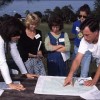 A result of the influx of new residents to the South is an expansion of urban areas into forests and other natural areas, creating areas referred to as the wildland-urban interface. Interface issues of most concern vary from state to state, but some key issues are consistent across the South. the US Forest Service conducted a series of focus groups in 2000. Key issues gleaned from those focus groups and other related sources are described in this 5-page fact sheet written by L. Annie Hermansen-Baez, Jennifer Seitz, and Martha C. Monroe, and published by the UF Department of School of Forest Resources and Conservation, February 2013.
A result of the influx of new residents to the South is an expansion of urban areas into forests and other natural areas, creating areas referred to as the wildland-urban interface. Interface issues of most concern vary from state to state, but some key issues are consistent across the South. the US Forest Service conducted a series of focus groups in 2000. Key issues gleaned from those focus groups and other related sources are described in this 5-page fact sheet written by L. Annie Hermansen-Baez, Jennifer Seitz, and Martha C. Monroe, and published by the UF Department of School of Forest Resources and Conservation, February 2013.
http://edis.ifas.ufl.edu/fr264
A Spatial Analysis of Cultural Ecosystem Service Valuation by Regional Stakeholders in Florida: A Coastal Application of the Social Values for Ecosystem Service (SolVES) Tool (SG129)
 How can we measure how Sarasota Bay residents value their area’s cultural ecosystem services? This 4-page fact sheet describes a project to use a geographic information system application, SolVES 2.0, to assess, map and quantify environmental benefits to people to assist in coastal development decisionmaking. Written by Alisa Cofin, Robert Swett, and Zachary Cole, and published by the UF Department of Sea Grant, November 2012.
How can we measure how Sarasota Bay residents value their area’s cultural ecosystem services? This 4-page fact sheet describes a project to use a geographic information system application, SolVES 2.0, to assess, map and quantify environmental benefits to people to assist in coastal development decisionmaking. Written by Alisa Cofin, Robert Swett, and Zachary Cole, and published by the UF Department of Sea Grant, November 2012.
http://edis.ifas.ufl.edu/sg129
2012 Florida Constitutional Amendments series
 In addition to 2012 being a presidential election year, Florida voters also will be asked to vote on a number of proposed amendments to their state constitution. Many voters remain either unaware or less informed regarding the effects and impacts of the proposed constitutional amendments. This series of 6 fact sheets was written by Rodney L. Clouser, and published by the UF Department of Food and Resource Economics, July 2012.
In addition to 2012 being a presidential election year, Florida voters also will be asked to vote on a number of proposed amendments to their state constitution. Many voters remain either unaware or less informed regarding the effects and impacts of the proposed constitutional amendments. This series of 6 fact sheets was written by Rodney L. Clouser, and published by the UF Department of Food and Resource Economics, July 2012.
- Amendment 2: Veterans Disabled Due to Combat Injury; Homestead Property Tax Discount
- Amendment 3: State Government Revenue Limitation
- Amendment 4: Property Tax Limitations; Property Value Decline; Reduction for Nonhomestead Assessment Increases, Delay of Scheduled Repeal
- Amendment 9: Homestead Property Tax Exemption for Surviving Spouse of Military Veteran or First Responder
- Amendment 10: Tangible Personal Property Tax Exemption
- Amendment 11: Additional Homestead Exemption; Low-Income Seniors Who Maintain Long-Term Residency on Property; Equal to Assessed Value
http://edis.ifas.ufl.edu/topic_2012_florida_constitutional_amendments
The Costs of Managing an Urban Forest (FOR217/FR279)
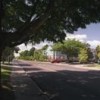 Urban forests provide benefits to society often referred to as ecosystem services: they improve human health, environmental quality, and local economies by increasing property values and aesthetics in communities. They help cities control storm water, reduce air pollution and energy costs, and offset carbon dioxide emissions. But urban forests also have “ecosystem disservices.” An accurate assessment of an urban forest’s costs can assist decision makers to better understand the role the forest plays in improving the well-being of the community. Identifying how funding is used can also help communities minimize costs and increase benefits. This 4-page fact sheet will review some of the types of costs associated with urban forests and present typical financial costs associated with urban forest management in the city of Gainesville, Florida. Written by Francisco Escobedo and Jennifer Seitz, and published by the UF Department of School of Forest Resources and Conservation, October 2012.
Urban forests provide benefits to society often referred to as ecosystem services: they improve human health, environmental quality, and local economies by increasing property values and aesthetics in communities. They help cities control storm water, reduce air pollution and energy costs, and offset carbon dioxide emissions. But urban forests also have “ecosystem disservices.” An accurate assessment of an urban forest’s costs can assist decision makers to better understand the role the forest plays in improving the well-being of the community. Identifying how funding is used can also help communities minimize costs and increase benefits. This 4-page fact sheet will review some of the types of costs associated with urban forests and present typical financial costs associated with urban forest management in the city of Gainesville, Florida. Written by Francisco Escobedo and Jennifer Seitz, and published by the UF Department of School of Forest Resources and Conservation, October 2012.
http://edis.ifas.ufl.edu/fr279
Forest Management in the Interface: Reducing Fire Risk (FOR179/FR249)
 Wildfire is one of the most serious and publicized challenges facing interface forest management. Wildfires can change forest vegetation, affect human health, and cause millions of dollars’ worth of damage to homes, businesses, timber, and tourism. This 5-page fact sheet outlines tips for the firewise community development, design of structures, landscaping and fuel reduction. Written by Bruce Hull, Sarah F. Ashton, Rien M. Visser, and Martha C. Monroe, and published by the UF Department of School of Forest Resources and Conservation, August 2012.
Wildfire is one of the most serious and publicized challenges facing interface forest management. Wildfires can change forest vegetation, affect human health, and cause millions of dollars’ worth of damage to homes, businesses, timber, and tourism. This 5-page fact sheet outlines tips for the firewise community development, design of structures, landscaping and fuel reduction. Written by Bruce Hull, Sarah F. Ashton, Rien M. Visser, and Martha C. Monroe, and published by the UF Department of School of Forest Resources and Conservation, August 2012.
http://edis.ifas.ufl.edu/fr249
Developing Land in Florida with Fire in Mind: Recommendations for Designers, Developers, and Decision Makers (FOR63/FR059)
 In 1998, fire destroyed or damaged 330 homes and businesses in Florida. Losses totaled more than $800 million. In some places, homes were saved by fire-fighting crews, or where the right decisions were made by builders or designers. With advance planning, architects and developers can do a great deal to reduce wildfire risk for those living and working in Florida. This 5-page fact sheet was written by Martha C. Monroe and Susan Marynowski, and published by the UF Department of School of Forest Resources and Conservation, September 2012.
In 1998, fire destroyed or damaged 330 homes and businesses in Florida. Losses totaled more than $800 million. In some places, homes were saved by fire-fighting crews, or where the right decisions were made by builders or designers. With advance planning, architects and developers can do a great deal to reduce wildfire risk for those living and working in Florida. This 5-page fact sheet was written by Martha C. Monroe and Susan Marynowski, and published by the UF Department of School of Forest Resources and Conservation, September 2012.
http://edis.ifas.ufl.edu/fr059
Conservation Subdivision: Post-construction Phase – Urban Trees Can Reduce Household Carbon Footprint (WEC321/UW366)
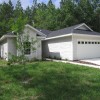 During the post-construction phase, the conservation and planting of native trees in individual yards and open spaces can reduce household and neighborhood carbon footprints. This 5-page fact sheet discusses the importance of urban trees and their role in mitigating for climate change by avoiding carbon emissions and removing carbon dioxide from the atmosphere. Written by Richard Vaughn, Mark Hostetler, and Francisco Escobedo, and published by the UF Department of Wildlife Ecology and Conservation, June 2012.
During the post-construction phase, the conservation and planting of native trees in individual yards and open spaces can reduce household and neighborhood carbon footprints. This 5-page fact sheet discusses the importance of urban trees and their role in mitigating for climate change by avoiding carbon emissions and removing carbon dioxide from the atmosphere. Written by Richard Vaughn, Mark Hostetler, and Francisco Escobedo, and published by the UF Department of Wildlife Ecology and Conservation, June 2012.
http://edis.ifas.ufl.edu/uw366
Involving Youth in the Community Development Process (FAR1214/FM451)
 “As communities face challenges and opportunities to help serve their residents, they’re often faced with a lack of resources, including volunteers. However, many parents are discovering that their children may not only want to volunteer, but many teenagers are required to volunteer if they’re pursuing a future in college.” This 2-page Family Album Radio transcript was written by Rosemary Barnett and Mark Brennan, and published by the UF Department of Family Youth and Community Sciences, July 2012.
“As communities face challenges and opportunities to help serve their residents, they’re often faced with a lack of resources, including volunteers. However, many parents are discovering that their children may not only want to volunteer, but many teenagers are required to volunteer if they’re pursuing a future in college.” This 2-page Family Album Radio transcript was written by Rosemary Barnett and Mark Brennan, and published by the UF Department of Family Youth and Community Sciences, July 2012.
http://edis.ifas.ufl.edu/fm451